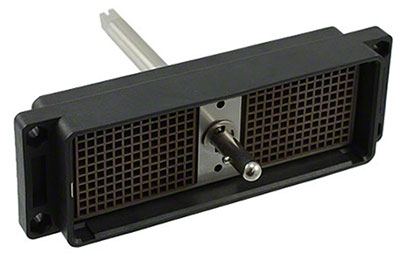ITT Cannon's DL Series Offers Hundreds of ZIF Connector Options
Imagine a service tech trying to swap out a critical board in a costly medical or commercial application: The connector resists, the tech pulls harder, and then comes a stiff, audible snap; the entire board needs replacement or, worse, a costly return to the supplier. That tug of war could be prevented by zero insertion force (ZIF) connectors, which make systems easier to assemble, test, and maintain without sacrificing performance.
As designs become increasingly complex, connector mating becomes ever more critical. Yet connectors may be the least considered part of a design until, like the service tech scenario, something breaks. Or, while trying to replace a cable, the insertion force required to seat the connector results in one or more bent pins, creating a fatal fault.
ZIF connectors can help designers avoid these problems. In doing so, they can lower the risk of field failures, reduce the training required for assemblers, and benefit from easier prototyping and testing.
Despite being a mature technology dating back to the 1970s, ZIF connectors simply aren't top-of-mind for many designers who are accustomed to standard connectors. They may be less concerned about downstream failures, unwilling to absorb added bill-of-materials costs, or reluctant to accommodate the cam-actuated locking mechanism that can be utilized in many of these connectors.
Traditional press-fit connectors can be placed almost anywhere on a board, while the ZIF connector needs clearance for the cam shaft and actuating handle used to ensure a correct insertion and lock it in place. This could be a deal-breaker in low-maintenance applications.
Sticking with high-insertion-force connectors due to cost sensitivity and footprint constraints may be reasonable when a design utilizes low-pin-count and the connector is static. But with high-density, high-cycle, or mission-critical applications, the reliability, ease of assembly, and lower long-term service cost of a rugged ZIF connector can far outweigh any higher unit price. In fact, by accommodating a greater number of contacts, the ZIF connector may allow for a smaller footprint.
Benefits of ZIF
The ability to pack hundreds of contacts into a compact area without risking bent pins is why ZIF connectors are so popular in medical imaging, test equipment, and aerospace panels, where reliability is non-negotiable.
ITT Cannon pioneered high-reliability connection solutions for demanding environments and has decades of engineering expertise to ensure that each balances precision, durability, and ease of use.
The company's high-density DL series can handle vibration, temperature swings, thousands of mating cycles, and can cost less per mated line than singular high-density rack-and-panel connectors. All DL series connectors employ a cam-actuated ZIF mechanism, ensuring effortless mating and unmating without stressing the contacts.
Some notable options include:
- For general-purpose applications, the DL1-156P plug housing with 156 non-gendered contacts (Figure 1), is an option for standard high-density connections where space is sufficient. The housing features a rotating latch coupling mechanism and is constructed from glass-filled thermoplastic, ensuring durability and reliability.
 Figure 1: The DLP-156P is designed for general-purpose applications. (Image source: ITT Cannon)
Figure 1: The DLP-156P is designed for general-purpose applications. (Image source: ITT Cannon)
- The DL1-156PW4A provides hermaphroditic contacts that allow engineers to create versatile board-to-board or cable-to-board connections without worrying about which side is male or female.
- The 96-position DL2-96P connector housing supports smaller form factors (Figure 2).
 Figure 2: The ITT Cannon DL2-96 connector accommodates more compact applications. (Image source: ITT Cannon)
Figure 2: The ITT Cannon DL2-96 connector accommodates more compact applications. (Image source: ITT Cannon)
- The DL5-260P (Figure 3) houses up to 260 non-gendered contacts to support higher-end industrial equipment and medical devices, among others.
 Figure 3: Accommodating up to 260 contacts, the DL5-260P is a fit for more complex applications. (Image source: ITT Cannon)
Figure 3: Accommodating up to 260 contacts, the DL5-260P is a fit for more complex applications. (Image source: ITT Cannon)
While the DL1, DL2, and DL3 series are generally unshielded for standard internal connections, the DL5 series provides high-density, high-pin-count solutions, and the DLM series adds integrated shielding and ruggedized construction for EMI-sensitive or harsh environments.
Conclusion
With dozens of configurations in terms of pin count, gender, contact type, and shielding, the ITT Canon DL series encompasses hundreds of variants for nearly any application. Designers can choose between male, female, or hermaphroditic contacts, allowing for flexible mating configurations and reducing inventory complexity. The series supports crimp, PCB post, and wire-wrap contacts to meet various assembly and reliability requirements.

Have questions or comments? Continue the conversation on TechForum, DigiKey's online community and technical resource.
Visit TechForum











